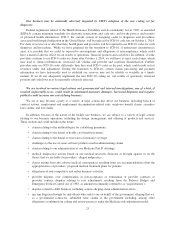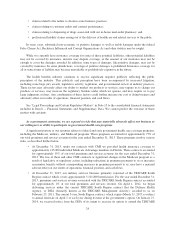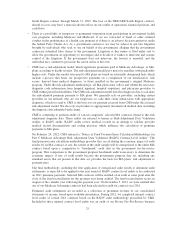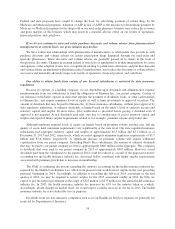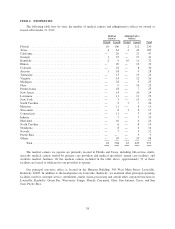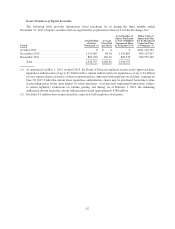Humana 2013 Annual Report Download - page 43
Download and view the complete annual report
Please find page 43 of the 2013 Humana annual report below. You can navigate through the pages in the report by either clicking on the pages listed below, or by using the keyword search tool below to find specific information within the annual report.In some situations, we have contracts with individual or groups of primary care providers for an actuarially
determined, fixed, per-member-per-month fee under which physicians are paid an amount to provide a basket of
required medical services to our members. This type of contract is referred to as a “capitation” contract. The
inability of providers to properly manage costs under these capitation arrangements can result in the financial
instability of these providers and the termination of their relationship with us. In addition, payment or other
disputes between a primary care provider and specialists with whom the primary care provider contracts can
result in a disruption in the provision of services to our members or a reduction in the services available to our
members. The financial instability or failure of a primary care provider to pay other providers for services
rendered could lead those other providers to demand payment from us even though we have made our regular
fixed payments to the primary provider. There can be no assurance that providers with whom we contract will
properly manage the costs of services, maintain financial solvency or avoid disputes with other providers. Any of
these events may have a material adverse effect on the provision of services to our members and our results of
operations, financial position, and cash flows.
Our pharmacy business is highly competitive and subjects us to regulations in addition to those we face
with our core health benefits businesses.
Our pharmacy business competes with locally owned drugstores, retail drugstore chains, supermarkets,
discount retailers, membership clubs, and Internet companies as well as other mail-order and long-term care
pharmacies. Our pharmacy business also subjects us to extensive federal, state, and local regulation. The practice
of pharmacy is generally regulated at the state level by state boards of pharmacy. Many of the states where we
deliver pharmaceuticals, including controlled substances, have laws and regulations that require out-of-state
mail-order pharmacies to register with that state’s board of pharmacy. In addition, some states have proposed
laws to regulate online pharmacies, and we may be subject to this legislation if it is passed. Federal agencies
further regulate our pharmacy operations. Pharmacies must register with the U.S. Drug Enforcement
Administration and individual state controlled substance authorities in order to dispense controlled substances. In
addition, the FDA inspects facilities in connection with procedures to effect recalls of prescription drugs. The
Federal Trade Commission also has requirements for mail-order sellers of goods. The U.S. Postal Service, or
USPS, has statutory authority to restrict the transmission of drugs and medicines through the mail to a degree that
may have an adverse effect on our mail-order operations. The USPS historically has exercised this statutory
authority only with respect to controlled substances. If the USPS restricts our ability to deliver drugs through the
mail, alternative means of delivery are available to us. However, alternative means of delivery could be
significantly more expensive. The Department of Transportation has regulatory authority to impose restrictions
on drugs inserted in the stream of commerce. These regulations generally do not apply to the USPS and its
operations. In addition, we are subject to CMS rules regarding the administration of our PDP plans and
intercompany pricing between our PDP plans and our pharmacy business.
We are also subject to risks inherent in the packaging and distribution of pharmaceuticals and other health
care products, and the application of state laws related to the operation of internet and mail-order pharmacies.
The failure to adhere to these laws and regulations may expose us to civil and criminal penalties.
Changes in the prescription drug industry pricing benchmarks may adversely affect our financial
performance.
Contracts in the prescription drug industry generally use certain published benchmarks to establish pricing
for prescription drugs. These benchmarks include average wholesale price, which is referred to as “AWP,”
average selling price, which is referred to as “ASP,” and wholesale acquisition cost. It is uncertain whether
payors, pharmacy providers, pharmacy benefit managers, or PBMs, and others in the prescription drug industry
will continue to utilize AWP as it has previously been calculated, or whether other pricing benchmarks will be
adopted for establishing prices within the industry. Legislation may lead to changes in the pricing for Medicare
and Medicaid programs. Regulators have conducted investigations into the use of AWP for federal program
payment, and whether the use of AWP has inflated drug expenditures by the Medicare and Medicaid programs.
33


